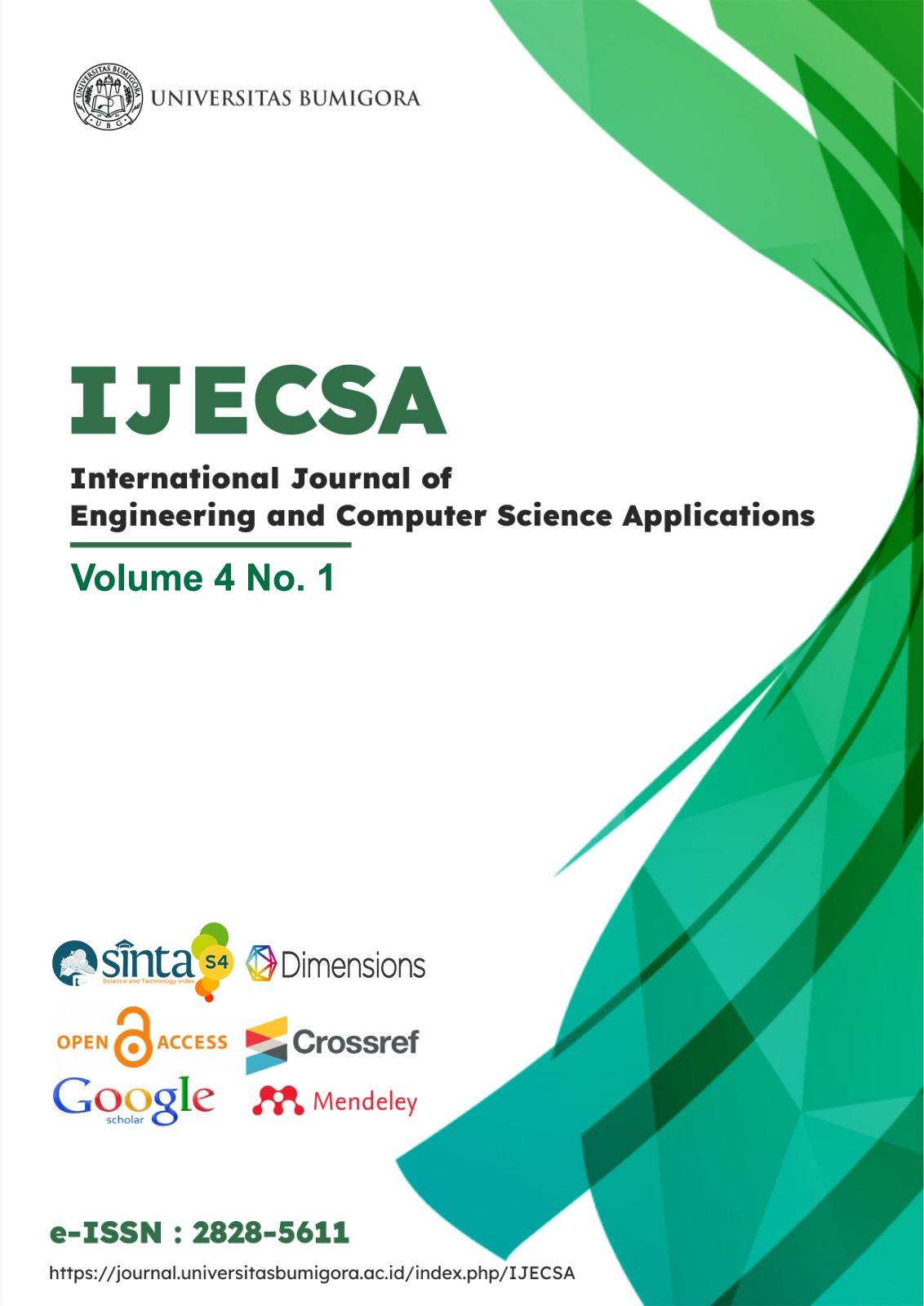Optimization of Renewable Energy From Solar Panels For Environmental Monitoring Using Arduino
Abstract
Renewable energy is an alternative energy in the midst of the issue of fossil-based energy running out. One of these alternative energies is solar panels that generate electricity to achieve environmentally friendly energy. The problem researched in this study is the need to optimize or energy efficiency of solar panels. The type of research is development research with a prototype model. The purpose of this study is to optimize the efficiency of the solar panel tracking system equipped with artificial intelligence and sensors to monitor the environment based on the internet of things. This research method is an integration of fuzzy logic internet of things for tracking solar panels based on light sensor input. The use of solar panels using polycrystalline types, and the addition of temperature and humidity sensors is important to utilize. The result of this study is that the highest efficiency is obtained at 9.96%, meaning that the energy received by the system is 9.96% into useful power that is lost. In conclusion, solar panels are highly dependent on weather conditions and the focal point of solar energy capture. The implication of this study is that the improvement of environmentally friendly energy efficiency, although not too high, can be further developed. Recommendations for further research suggest that data collection be carried out in sunny weather, and improved using solar panels with a larger capacity and energy storage from batteries. The use of machine learning algorithms can be an alternative to study large amounts of solar panel data.
References
[2] A. M. Yusop, M. A. S. M. Shabri, N. A. Sulaiman, K. N. Khamil, R. Mohammed, and J. M. Sultan, “Development and Evaluation of Dual Axis Solar Tracking System with IoT Data Monitoring,” Prz. Elektrotechniczny, vol. 99, no. 1, pp. 28–32, 2023, doi: 10.15199/48.2023.01.05.
[3] P. Muthukumar, S. Manikandan, R. Muniraj, T. Jarin, and A. Sebi, “Energy efficient dual axis solar tracking system using IOT,” Meas. Sensors, vol. 28, Aug. 2023, doi: 10.1016/j.measen.2023.100825.
[4] A. Henukh, A. Heri, A. Algiranto, and M. Simbolon, “Solar Tracker Design Based on Arduino Nano to Improve Solar Energy Efficiency,” Tech. Rom. J. Appl. Sci. Technol., vol. 16, pp. 460–464, 2023, doi: 10.47577/technium.v16i.10029.
[5] D. Rajan and E. T. Ramachandran, “Design and Development of Sun Tracking Solar Panel,” Int. J. Adv. Eng. Manag., vol. 3, no. 9, pp. 1343–1357, 2021, doi: 10.35629/5252-030913431357.
[6] K. Krismadinata et al., “Photovoltaic Energy Harvesting with Static and Dynamic Solar Modules Employing IoT-Enabled Performance Monitoring,” TEM J., vol. 12, no. 3, pp. 1354–1363, Aug. 2023, doi: 10.18421/TEM123-15.
[7] Y. R. Al-Saadi, M. S. Tapou, A. A. Badi, S. Abdulla, and M. Diykh, “Developing Smart Self Orienting Solar Tracker for Mobile PV Power Generation Systems,” IEEE Access, vol. 10, no. July, pp. 79090–79099, 2022, doi: 10.1109/ACCESS.2022.3194026.
[8] S. H. Ga, H. J. Cha, and C. J. Kim, “Adapting Internet of Things to Arduino-Based Devices for Low-Cost Remote Sensing in School Science Learning Environments,” Int. J. online Biomed. Eng., vol. 17, no. 2, pp. 4–18, 2021, doi: 10.3991/ijoe.v17i02.20089.
[9] S. Setiyono and K. Wibowo, “The Solar Tracker Prototype Based on Arduino Uno,” J. Ecotipe (Electronic, Control. Telecommun. Information, Power Eng., vol. 11, no. 1, pp. 38–45, Apr. 2024, doi: 10.33019/jurnalecotipe.v11i1.4481.
[10] B. A. Hamad and A. M. . Ibraheem, “Design and Implementation of a Dual-Axis Solar Tracking System STS,” NTU J. Eng. Technol., vol. 1, no. 1, pp. 35–43, 2021, doi: 10.56286/ntujet.v1i1.84.
[11] W. A. W. A. Bakar, M. Man, N. L. N. Josdi, and Z. H. Amir, “Design of Solar Tracking System for Solar Panel Using Microcontroller Based on Internet of Things,” Int. J. Sci. Res., vol. 04, no. 01, pp. 37–42, 2024, doi: 10.25299/IJSR.2023.11xxxx.
[12] K. Patel, S. Borole, K. Ramaneti, A. Hejib, and R. R. Singh, “Design and implementation of Sun Tracking Solar Panel and Smart Wiping Mechanism using Tinkercad,” in IOP Conference Series: Materials Science and Engineering, IOP Publishing Ltd, Aug. 2020, pp. 1–12. doi: 10.1088/1757-899X/906/1/012030.
[13] S. E. Gun, L. Halim, and F. Wahab, “Solar Panel Efficiency Improvement through Dual-Axis Solar Tracking with Fuzzy Logic and Water Treatment Techniques,” J. Nas. Tek. Elektro, vol. 12, no. 03, pp. 20–29, Nov. 2023, doi: 10.25077/jnte.v12n3.1120.2023.
[14] H. H. Rangkuti, N. P. Sinaga, and F. Ariani, “Solar tracker design on solar panel for stm32 microcontroller based on battery charging system,” IOP Conf. Ser. Earth Environ. Sci., vol. 1115, no. 1, 2022, doi: 10.1088/1755-1315/1115/1/012078.
[15] L. F. Wong, H. N. Afrouzi, and J. Tavalaei, “Design and implementation of a dual-axis sun tracker for an Arduino-based micro-controller photovoltaic system,” Futur. Technol., vol. 3, no. 3, pp. 15–19, 2024, doi: 10.55670/fpll.futech.3.3.3.
[16] L. A. A. Rahaim, A. A. Abdullah, and A. K. L. Aquraishi, “IoT Cloud System Based Dual Axis Solar Tracker Using Arduino,” J. Internet Serv. Inf. Secur., vol. 13, no. 2, pp. 193–202, 2023, doi: 10.58346/JISIS.2023.I2.012.
[17] F. A. Silaban, A. G. Rolanda, L. M. Silalahi, and S. Budiyanto, “Solar Panel Drive Design Based Internet of Things,” CCIT (Creative Commun. Innov. Technol. J., vol. 16, no. 1, pp. 100–110, 2023, Accessed: Mar. 03, 2024. [Online]. Available: https://garuda.kemdikbud.go.id/documents/detail/3304984

This work is licensed under a Creative Commons Attribution-ShareAlike 4.0 International License.












